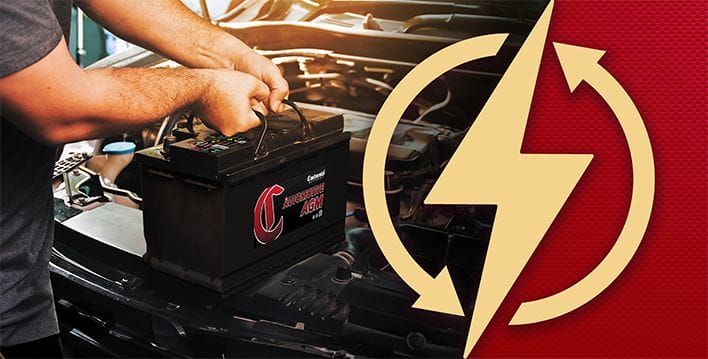
You’ve probably encountered a traditional, lead-acid battery in your lifetime, but you might be less familiar with deep cycle batteries — unless you have experience with recreational vehicles, boats or golf carts. But what’s the difference, and does it really matter which battery type goes into your vehicles?
Traditional lead-acid batteries and deep cycle batteries are actually designed for different uses and power output, so knowing the difference between regular lead-acid and deep cycle batteries is crucial. Choosing the wrong battery for your vehicle could leave you with a dead battery, or a lack of power to get from one point to the next — or it could cause long-term damage to other car parts, like the alternator.
Before you start shopping for vehicle batteries, it’s important to know the differences between traditional batteries and deep cycle batteries, how they work and when to use them.
What Is a Traditional Lead-Acid Battery?
A traditional lead-acid battery is probably what you think of when you imagine a car battery. This type of battery typically has six connected cells inside. There are lead plates and lead dioxide plates within each cell. The lead-acid battery has a positively charged cathode, a negatively charged anode and sulfuric acid, also called the electrolyte.
How Does a Lead-Acid Battery Work?
To provide power to the vehicle, the electrolyte reacts with the lead plates to create ions, which also react with the lead plates and create lead sulfate and hydrogen. As these ions move around to the cathode and anode, they produce the electricity needed to power up the engine. The reactions are reversed to recharge the battery.
This setup allows a traditional lead-acid battery to supply a short burst of power to start up the engine. The continued energy supply to keep the car moving is actually provided by the alternator after the battery powers up the engine via chemical reactions.
What Is a Deep Cycle Battery?
Deep cycle batteries are designed to handle states of deep discharge, or depth of discharge (DoD), which is how much of the battery capacity is used in one full discharge of the battery. There are different types of deep cycle batteries.
Flooded deep cycle batteries will require the user to refill the electrolyte levels to maintain the battery, while sealed lead-acid batteries are a type of deep cycle battery that requires little maintenance and are spill-proof. This quality makes deep cycle batteries a good choice for recreational vehicles that may experience a lot of bumps and vibrations.
How Does a Deep Cycle Battery Work?
Deep cycle batteries have thicker lead plates compared to traditional lead-acid batteries, allowing the battery to provide longer sustained amounts of electricity but less power compared to traditional batteries. These batteries can withstand 80% or higher DoD, although the lifespan of the battery will benefit from keeping the DoD above 50%.
Deep Cycle Battery vs. Lead-Acid Battery
Now that you know how these battery types work, it’s time to explore the benefits and shortcomings of each. Plus, we’ll dive into when to rely on deep cycle batteries versus when to install lead-acid batteries in your vehicles.
Use Cases
Because of their different designs, deep cycle and traditional lead-acid batteries work for vastly different scenarios.
- Deep cycle batteries aren’t often found in everyday vehicles, like cars and trucks. Instead, they work to provide a steady supply of a lower amount of power compared to traditional batteries, making them ideal for recreational vehicles, boats, golf carts and electric vehicles, such as medical carts or electric bikes.
- Traditional lead-acid batteries are probably familiar to most drivers, as these are common in many everyday vehicles, like cars, SUVs, trucks and other light-duty vehicles that need short bursts of power to start up the vehicle engine.
CCA vs. RC
When you’re looking into deep cycle batteries and traditional lead-acid batteries, you’ll come across the terms cold cranking amps (CCA) and reserve capacity (RC).
- CCA indicates the number of amps a battery produces in 30 seconds at 0°C (32°F) while maintaining a minimum of 7.2 voltage.
- RC is the number of minutes a battery can produce 25 amps with a minimum of 10.5 voltage.
A lead-acid battery will provide about two times more CCA compared to a deep cycle battery, while a deep cycle battery provides two or three times as much RC as a traditional lead-acid battery.
Pros of Deep Cycle Batteries
Deep cycle batteries have several benefits, depending on the situation. Many of their benefits, like sustained energy and long cycle lifespan, make them ideal for recreational vehicle use.
- Cycles. Deep cycle batteries last for about 2,000 cycles, with each cycle representing a full discharge and recharge, while traditional lead-acid batteries last about 200 cycles and aren’t designed for deep discharging.
- RC. A deep cycle battery has a much higher RC compared to regular batteries and provides more sustained energy.
- Size. Deep cycle batteries are smaller and lighter in weight than regular batteries, which is why they work so well in recreational vehicles.
Cons of Deep Cycle Batteries
Not every vehicle will benefit from a deep cycle battery, as they do have some drawbacks that won’t allow them to work in every setting.
- CCA. Deep cycle batteries provide half to three-quarters less CCA than a traditional lead-acid battery.
- Power. With the lower CCA, deep cycle batteries do not provide the large bursts of power that a traditional lead-acid battery can provide to a vehicle.
- Recharging. Users will need to manually recharge deep cycle batteries.
Pros of Lead-Acid Batteries
Lead-acid batteries are ubiquitous in many of the vehicles we come across every day because they have many benefits for modern cars and trucks.
- Power. Lead-acid batteries provide large bursts of power to start a vehicle engine, and they rarely reach more than 20% DoD.
- Recharging. The vehicle alternator helps recharge the battery, so users do not need to manually recharge traditional lead-acid batteries.
- Cost. Lead-acid batteries are everywhere, and as the most common vehicle battery, they are easy to find and affordable.
Cons of Lead-Acid Batteries
Lead-acid batteries have some drawbacks that make them less suitable for certain applications, and unlike maintenance-free deep cycle battery varieties, they do require regular inspections and maintenance.
- Limited capacity. Lead-acid batteries aren’t designed to reach a deep state of discharge the way that deep cycle batteries can and have a much lower RC compared to deep cycle batteries.
- Maintenance. Lead-acid batteries need regular inspections and must be refilled to prevent battery damage.
- Temperature resistance. Lead-acid batteries don’t hold up well to extreme temperatures, either hot or cold. The lifespan of lead-acid batteries can be cut short when used frequently in high heat or freezing temperatures.
Meet Battery Supply Needs for All Battery Types
Batteries aren’t one-size-fits-all, so it’s important to understand how each one works to deliver power to different types of vehicles. Whether your clientele wants to go off-roading in recreational vehicles or needs to rely on you for in-stock lead-acid batteries for their everyday cars and trucks, knowing these batteries inside and out is key to servicing your customers.






